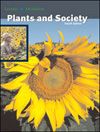NEW IN THE FOURTH EDITION
Plant science is a dynamic field, and we have updated and incorporated new information into most of the chapters. We have also added to and revised many of the photographs, drawings, and tables to improve the visual impact of the fourth edition. We have added a section on a stem vegetable—asparagus—as a complement to the root and leaf vegetables highlighted in Chapter 3. Also, the findings of molecular systematics have necessitated updates in the classification of the bryophytes, whisk ferns, algae, and fungi in Chapters 9, 22, and 23 respectively.PLANTS AND HEALTH
The connection between plants and health continues to be a major theme in this edition, and we have added several updates and new topics. Chapter 19 documents the ground-breaking action of the FDA in banning ephedrine and the related pseudoephedrine in dietary and herbal supplements. The Chinese Happy Tree is the source of a promising new class of cancer drugs that work by inhibiting DNA repair and replication. Chapter 20 includes information on recent research about the brain’s reward circuit and how it explains the physiology of drug addiction. Forty years after the first warning about the hazards of smoking to health, a new report by the Surgeon General implicates cigarette smoking in more diseases in nearly every organ of the body than previously suspected. New concerns are also reported for kava, a popular psychoactive herbal export from the South Pacific, and its possible link to cases of liver toxicity in Europe. A Closer Look 22.1: Drugs from the Sea has been expanded to include the latest in the development of algal-based medications. The newest information on how and why moderate consumption of alcohol lowers the risk of coronary heart disease and type 2 diabetes is discussed in Chapter 24.ADVANCES IN HUMAN NUTRITION
Chapter 10 has been reworked to include the many advances that have been made in our understanding of human nutrition. These include the proposed revision of the USDA’s Food Pyramid from its promotion of a high-carbohydrate, low-fat diet; the global epidemic of obesity in adults and children, its causes, and consequences; and the association between trans fats in the diet and higher risks for cardiovascular disease and type 2 diabetes.DEVELOPMENTS AND DISCOVERIES IN AGRICULTURE
Several updates on agricultural topics have been added to this edition. In Chapter 11, evidence from forensic botany is changing long-held ideas about the prevalence of early agriculture. Charred seeds of wild plants found in ancient cook fires may not indicate the diet of foraging ancestors, as previously thought, but rather the diet of domesticated animals whose dung fueled the fires. Additionally, phytolith analysis has uncovered evidence of early agriculture in unsuspected places, such as the New Guinea Highlands and the lowland tropics of Central and South America. Chapter 15 documents the value of seed banks in restoring agriculture to post-Taliban Afghanistan. The public uproar over genetically engineered crops such as herbicide-resistant wheat and transgenic crops with terminator genes is discussed in the same chapter. In Chapter 18, the benefits of producing Bt cotton in India and other developing nations is explored.Plants and Environmental Issues
Recent environmental issues are addressed in several chapters. In Chapter 21, the mysterious deaths of hundreds of elk in Wyoming were traced to consumption of lichens with unusually high concentrations of usnic acid, a natural metabolite. Chapter 23 discusses the deadly plant pathogen Phytophora ramoroum, which has been identified as the fungal agent of the disease, sudden oak death that is killing several woody species along the west coast of the United States. Chapter 9 presents a fascinating example of biological magnification that may explain the high incidence of a neurological disease in Guam. In this case, a cyanobacterial toxin is passed on to cycads and accumulates in deadly concentrations as it moves from cycad seeds to bats to human consumers. As the world warms from rising levels of atmospheric CO2 ,evidence is presented in Chapter 26 that a variety of species are already being affected. Phenological events for many species are occurring earlier, and some interspecies relationships are now out of synchrony, disrupting food chains and affecting species survival rates. Experimental data have shown that certain invasive species are likely to thrive in a CO2 -enriched environment as native species decline. A major environmental controversy is being debated on whether tropical rain forests will act as carbon sinks or sources in response to higher levels of CO2. And the destruction of tropical rain forests is already impacting the primary source of health care for many people in developing nations as native medicinal plants become scarce or unavailable. The future of Brazil nuts as an extractive reserve to save the tropical rain forest is in question because of intense harvesting that is threatening survival of this economically important tree. LEARNING ONLINE
The Learning Online feature can be found at the end of every chapter. This list of chapter-related topics mimics an identical list on the website that accompanies this textbook. The
list on the website is linked to crucial information on each of these topics. The links are updated periodically through our database to help students stay on top of their research and
study responsibilities. |



 2006 McGraw-Hill Higher Education
2006 McGraw-Hill Higher Education

 2006 McGraw-Hill Higher Education
2006 McGraw-Hill Higher Education